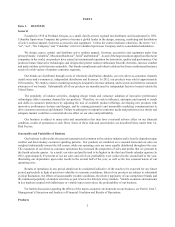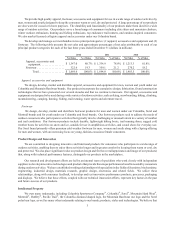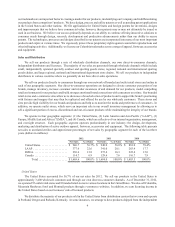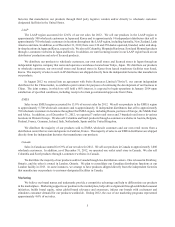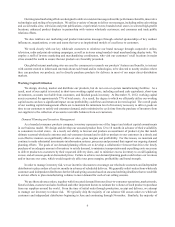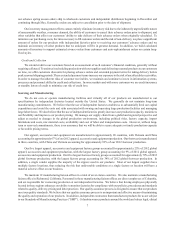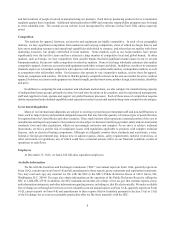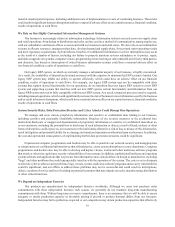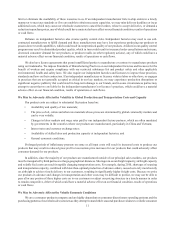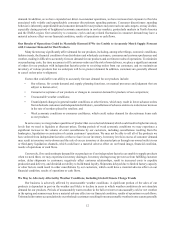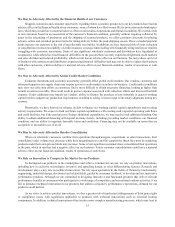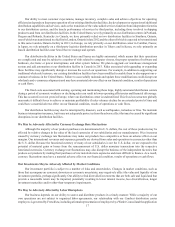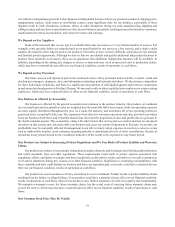Columbia Sportswear 2012 Annual Report Download - page 16
Download and view the complete annual report
Please find page 16 of the 2012 Columbia Sportswear annual report below. You can navigate through the pages in the report by either clicking on the pages listed below, or by using the keyword search tool below to find specific information within the annual report.12
demand. In addition, as we have expanded our direct-to-consumer operations, we have increased our exposure to the risks
associated with volatile and unpredictable consumer discretionary spending patterns. Consumer discretionary spending
behavior is inherently unpredictable and consumer demand for our products may not reach our sales targets, or may decline,
especially during periods of heightened economic uncertainty in our key markets, particularly markets in North America
and the EMEA region. Our sensitivity to economic cycles and any related fluctuation in consumer demand may have a
material adverse effect on our financial condition, results of operations or cash flows.
Our Results of Operations Could be Materially Harmed If We Are Unable to Accurately Match Supply Forecast
with Consumer Demand for Our Products
Many factors may significantly affect demand for our products, including, among other things, economic conditions,
fashion trends, the financial condition of our distributors and wholesale customers, consumer and customer preferences and
weather, making it difficult to accurately forecast demand for our products and our future results of operations. To minimize
our purchasing costs, the time necessary to fill customer orders and the risk of non-delivery, we place a significant amount
of orders for our products with independent factories prior to receiving orders from our customers, and we maintain an
inventory of various products that we anticipate will be in greatest demand. In addition, customers are generally allowed
to cancel orders prior to shipment.
Factors that could affect our ability to accurately forecast demand for our products include:
• Our reliance, for certain demand and supply planning functions, on manual processes and judgment that are
subject to human error;
• Consumer acceptance of our products or changes in consumer demand for products of our competitors;
• Unseasonable weather conditions;
• Unanticipated changes in general market conditions or other factors, which may result in lower advance orders
from wholesale customers and independent distributors, cancellations of advance orders or a reduction or increase
in the rate of reorders placed by retailers; and
• Weak economic conditions or consumer confidence, which could reduce demand for discretionary items such
as our products.
In some cases, we may produce quantities of product that exceed actual demand, which could result in higher inventory
levels that we need to liquidate at discount prices. During periods of weak economic conditions we may experience a
significant increase in the volume of order cancellations by our customers, including cancellations resulting from the
bankruptcy, liquidation or contraction of certain customers’ operations. We may not be able to sell all of the products we
have ordered from independent factories or that we have in our inventory. Inventory levels in excess of customer demand
may result in inventory write-downs and the sale of excess inventory at discounted prices through our owned outlet stores
or third-party liquidation channels, which could have a material adverse effect on our brand image, financial condition,
results of operations or cash flows.
Conversely, if we underestimate demand for our products or if our independent factories are unable to supply products
when we need them, we may experience inventory shortages. Inventory shortages may prevent us from fulfilling customer
orders, delay shipments to customers, negatively affect customer relationships, result in increased costs to expedite
production and delivery, and diminish our ability to build brand loyalty. Shipments delayed due to limited factory capacity
or other factors could result in order cancellations by our customers, which could have a material adverse effect on our
financial condition, results of operations or cash flows.
We May be Adversely Affected by Weather Conditions, Including Global Climate Change Trends
Our business is adversely affected by unseasonable weather conditions. A significant portion of the sales of our
products is dependent in part on the weather and likely to decline in years in which weather conditions do not stimulate
demand for our products. Periods of unseasonably warm weather in the fall or winter or unseasonably cold or wet weather
in the spring and summer may have a material adverse effect on our financial condition, results of operations or cash flows.
Unintended inventory accumulation by our wholesale customers resulting from unseasonable weather in one season generally


